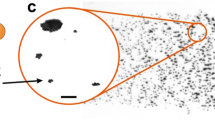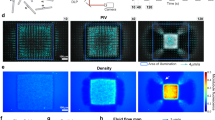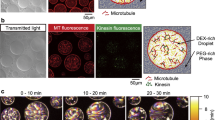Abstract
Directed transport of microcargoes is essential for living organisms as well as for applications in microrobotics, nanotechnology and biomedicine. Existing delivery technologies often suffer from low speeds, limited navigation control and dispersal by cardiovascular flows. In cell biology, these issues are largely overcome by cytoskeletal motors that carry vesicles along microtubule highways. Thus inspired, here we developed an artificial microtubule (AMT), a structured microfibre with embedded micromagnets that serve as stepping stones to guide particles rapidly through flow networks. Compared with established techniques, the microcargo travels an order of magnitude faster using the same driving frequency, and dispersal is mitigated by a strong dynamic anchoring effect. Even against strong fluid flows, the large local magnetic-field gradients enable both anchoring and guided propulsion. Finally, we show that AMTs can facilitate the self-assembly of microparticles into active-matter clusters, which then enhance their walking speed by bridging over stepping stones collectively. Hence, we demonstrate a unique strategy for robust delivery inside microvascular networks and for minimally invasive interventions, with non-equilibrium effects that could be equally relevant for enhancing biological transport processes.
This is a preview of subscription content, access via your institution
Access options
Access Nature and 54 other Nature Portfolio journals
Get Nature+, our best-value online-access subscription
$29.99 / 30 days
cancel any time
Subscribe to this journal
Receive 12 digital issues and online access to articles
$119.00 per year
only $9.92 per issue
Buy this article
- Purchase on Springer Link
- Instant access to full article PDF
Prices may be subject to local taxes which are calculated during checkout





Similar content being viewed by others
Data availability
All data are available in the main text or the Supplementary Information.
Code availability
All the relevant code used to generate the results in this paper and Supplementary Information is available upon request.
References
Phillips, R., Kondev, J., Theriot, J. & Garcia, H. Physical Biology Of The Cell (Garland Science, 2012).
Elgeti, J., Winkler, R. G. & Gompper, G. Physics of microswimmers—single particle motion and collective behavior: a review. Reports Prog. Phys. 78, 056601 (2015).
Needleman, D. & Dogic, Z. Active matter at the interface between materials science and cell biology. Nat. Rev. Mater. 2, 17048 (2017).
Ramirez-San Juan, G. R. et al. Multi-scale spatial heterogeneity enhances particle clearance in airway ciliary arrays. Nat. Phys. 16, 958–964 (2020).
Hirokawa, N., Noda, Y., Tanaka, Y. & Niwa, S. Kinesin superfamily motor proteins and intracellular transport. Nat. Rev. Mol. Cell Biol. 10, 682–696 (2009).
Schliwa, M. & Woehlke, G. Molecular motors. Nature 422, 759–765 (2003).
Visscher, K., Schnitzer, M. J. & Block, S. M. Single kinesin molecules studied with a molecular force clamp. Nature 400, 184–189 (1999).
Goldstein, R. E. & van de Meent, J.-W. A physical perspective on cytoplasmic streaming. Interface Focus 5, 20150030 (2015).
Chen, L., Nakamura, M., Schindler, T. D., Parker, D. & Bryant, Z. Engineering controllable bidirectional molecular motors based on myosin. Nat. Nanotechnol. 7, 252–256 (2012).
Kassem, S. et al. Artificial molecular motors. Chem. Soc. Rev. 46, 2592–2621 (2017).
Fredy, J. W. et al. Molecular photoswitches mediating the strain-driven disassembly of supramolecular tubules. Proc. Natl Acad. Sci. USA 114, 11850–11855 (2017).
Cheng, S., Aggarwal, A. & Stevens, M. J. Self-assembly of artificial microtubules. Soft Matter 8, 5666–5678 (2012).
Lubbe, A. S., Wezenberg, S. J. & Feringa, B. L. Artificial microtubules burst with energy. Proc. Natl Acad. Sci. USA 114, 11804–11805 (2017).
Nelson, B. J., Kaliakatsos, I. K. & Abbott, J. J. Microrobots for minimally invasive medicine. Annu. Rev. Biomed. Eng. 12, 55–85 (2010).
Li, J., de Ávila, B. E.-F., Gao, W., Zhang, L. & Wang, J. Micro/nanorobots for biomedicine: delivery, surgery, sensing, and detoxification. Sci. Robot. 2, eaam6431 (2017).
Goel, A. & Vogel, V. Harnessing biological motors to engineer systems for nanoscale transport and assembly. Nat. Nanotechnol. 3, 465–475 (2008).
Rosenblum, D., Joshi, N., Tao, W., Karp, J. M. & Peer, D. Progress and challenges towards targeted delivery of cancer therapeutics. Nat. Commun. 9, 1410 (2018).
Schmidt, C. K., Medina-Sánchez, M., Edmondson, R. J. & Schmidt, O. G. Engineering microrobots for targeted cancer therapies from a medical perspective. Nat. Commun. 11, 5618 (2020).
Cui, J., Huang, T., Luo, Z., Testa, P. & Gu, H. Nanomagnetic encoding of shape-morphing micromachines. Nature 575, 164–168 (2019).
Palagi, S. et al. Structured light enables biomimetic swimming and versatile locomotion of photoresponsive soft microrobots. Nat. Mater. 15, 647–653 (2016).
Zhang, L. et al. Artificial bacterial flagella: fabrication and magnetic control. Appl. Phys. Lett. 94, 64107 (2009).
Ghosh, A. & Fischer, P. Controlled propulsion of artificial magnetic nanostructured propellers. Nano Lett. 9, 2243–2245 (2009).
Servant, A., Qiu, F., Mazza, M., Kostarelos, K. & Nelson, B. J. Controlled in vivo swimming of a swarm of bacteria-like microrobotic flagella. Adv. Mater. 27, 2981–2988 (2015).
Huang, T.-Y., Gu, H. & Nelson, B. J. Increasingly intelligent micromachines. Annu. Rev. Control. Robot. Auton. Syst. 5, 279–310 (2022).
Ahmed, D. et al. Bioinspired acousto-magnetic microswarm robots with upstream motility. Nat. Mach. Intell. 3, 116–124 (2021).
Yang, T. et al. Microwheels on microroads: enhanced translation on topographic surfaces. Sci. Robot. 4, eaaw9525 (2019).
Wang, Q. et al. Ultrasound Doppler-guided real-time navigation of a magnetic microswarm for active endovascular delivery. Sci. Adv. 7, eabe5914 (2021).
Alapan, Y., Bozuyuk, U., Erkoc, P., Karacakol, A. C. & Sitti, M. Multifunctional surface microrollers for targeted cargo delivery in physiological blood flow. Sci. Robot. 5, eaba5726 (2020).
Wang, B. et al. Endoscopy-assisted magnetic navigation of biohybrid soft microrobots with rapid endoluminal delivery and imaging. Sci. Robot. 6, eabd2813 (2021).
Pancaldi, L. et al. Flow driven robotic navigation of microengineered endovascular probes. Nat. Commun. 11, 6356 (2020).
Vitiello, V., Lee, S.-L., Cundy, T. P. & Yang, G.-Z. Emerging robotic platforms for minimally invasive surgery. IEEE Rev. Biomed. Eng. 6, 111–126 (2012).
Kim, Y., Parada, G. A., Liu, S. & Zhao, X. Ferromagnetic soft continuum robots. Sci. Robot. 4, eaax7329 (2019).
Azizi, A., Tremblay, C. C., Gagné, K. & Martel, S. Using the fringe field of a clinical MRI scanner enables robotic navigation of tethered instruments in deeper vascular regions. Sci. Robot. 4, eaax7342 (2019).
Neuman, K. C. & Nagy, A. Single-molecule force spectroscopy: optical tweezers, magnetic tweezers and atomic force microscopy. Nat. Methods 5, 491–505 (2008).
Gosse, C. & Croquette, V. Magnetic tweezers: micromanipulation and force measurement at the molecular level. Biophys. J. 82, 3314–3329 (2002).
Moerland, C. P., Van IJzendoorn, L. J. & Prins, M. W. J. Rotating magnetic particles for lab-on-chip applications—a comprehensive review. Lab Chip 19, 919–933 (2019).
Katsikis, G., Cybulski, J. S. & Prakash, M. Synchronous universal droplet logic and control. Nat. Phys. 11, 588–596 (2015).
Gong, X., Mathijssen, A.J.T.M., Bryant, Z. & Prakash, M. Engineering reconfigurable flow patterns via surface-driven light-controlled active matter. Phys. Rev. Fluids 6, 123104 (2021).
Dendukuri, D., Pregibon, D. C., Collins, J., Hatton, T. A. & Doyle, P. S. Continuous-flow lithography for high-throughput microparticle synthesis. Nat. Mater. 5, 365–369 (2006).
Malgaretti, P., Pagonabarraga, I. & Frenkel, D. Running faster together: huge speed up of thermal ratchets due to hydrodynamic coupling. Phys. Rev. Lett. 109, 168101 (2012).
Malgaretti, P., Pagonabarraga, I. & Joanny, J.-F. Bistability, oscillations, and bidirectional motion of ensemble of hydrodynamically coupled molecular motors. Phys. Rev. Lett. 119, 168101 (2017).
Zhang, L. et al. Characterizing the swimming properties of artificial bacterial flagella. Nano Lett. 9, 3663–3667 (2009).
Tottori, S. et al. Magnetic helical micromachines: fabrication, controlled swimming, and cargo transport. Adv. Mater. 24, 811–816 (2012).
Peters, C. et al. Superparamagnetic twist-type actuators with shape-independent magnetic properties and surface functionalization for advanced biomedical applications. Adv. Funct. Mater. 24, 5269–5276 (2014).
Maier, A. M. et al. Magnetic propulsion of microswimmers with DNA-based flagellar bundles. Nano Lett. 16, 906–910 (2016).
Medina-Sánchez, M., Schwarz, L., Meyer, A. K., Hebenstreit, F. & Schmidt, O. G. Cellular cargo delivery: toward assisted fertilization by sperm-carrying micromotors. Nano Lett. 16, 555–561 (2016).
Huang, T.-Y. et al. 3D printed microtransporters: Compound micromachines for spatiotemporally controlled delivery of therapeutic agents. Adv. Mater. 27, 6644–6650 (2015).
Dreyfus, R. et al. Microscopic artificial swimmers. Nature 437, 862–865 (2005).
Pak, O. S., Gao, W., Wang, J. & Lauga, E. High-speed propulsion of flexible nanowire motors: theory and experiments. Soft Matter 7, 8169–8181 (2011).
Diller, E., Zhuang, J., Zhan Lum, G., Edwards, M. R. & Sitti, M. Continuously distributed magnetization profile for millimeter-scale elastomeric undulatory swimming. Appl. Phys. Lett. 104, 174101 (2014).
Jang, B. et al. Undulatory locomotion of magnetic multilink nanoswimmers. Nano Lett. 15, 4829–4833 (2015).
Li, T. et al. Magnetically propelled fish-like nanoswimmers. Small 12, 6098–6105 (2016).
Tasci, T. O., Herson, P. S., Neeves, K. B. & Marr, D. W. M. Surface-enabled propulsion and control of colloidal microwheels. Nat. Commun. 7, 10225 (2016).
Tierno, P., Golestanian, R., Pagonabarraga, I. & Sagués, F. Controlled swimming in confined fluids of magnetically actuated colloidal rotors. Phys. Rev. Lett. 101, 218304 (2008).
Sing, C. E., Schmid, L., Schneider, M. F., Franke, T. & Alexander-Katz, A. Controlled surface-induced flows from the motion of self-assembled colloidal walkers. Proc. Natl Acad. Sci. USA 107, 535–540 (2010).
Ahmed, D. et al. Neutrophil-inspired propulsion in a combined acoustic and magnetic field. Nat. Commun. 8, 770 (2017).
Acknowledgements
We thank X.-P. Wang and S. Pane for helping with the development of the fabrication process. We thank X. Chen for his help on the VSM test and E. Zuurmond for proofreading this article. The sample fabrication was performed using the cleanroom facilities at the FIRST at ETH Zurich. We thank the ETH Lab Supporting Group for the deposition process. Funding: This work was financially supported by the European Research Council Advanced Grant–Soft MicroRobots (SOMBOT, number 743217), Swiss National Science Foundation grant 200020B_185039 and an ETH grant (1916-1).
Author information
Authors and Affiliations
Contributions
H.G. conceived the idea and managed the research. E.H., H.G. and T.-Y.H. fabricated the artificial microtubules. H.G. and E.H. performed the experiments and analysed the data. A.J.T.M.M. and H.G. developed the theoretical model. H.G., A.J.T.M.M. and Q.B. wrote the manuscript with contributions from all authors. B.J.N. supervised this project.
Corresponding authors
Ethics declarations
Competing interests
The authors declare no competing interests.
Peer review
Peer review information
Nature Machine Intelligence thanks Gerhard Gompper and the other, anonymous, reviewer(s) for their contribution to the peer review of this work.
Additional information
Publisher’s note Springer Nature remains neutral with regard to jurisdictional claims in published maps and institutional affiliations.
Extended data
Extended Data Fig. 1 Fabrication process of artificial microtubules.
a, Schematic illustration of the microfabrication processes of the AMTs. The details of the microfabrication can be found in Methods: Fabrication of AMTs. b, SEM images of the microtubule samples with different electroplating time. Under an optimal electroplating time, the nickel plates have the same height as the SU-8 fibre.
Extended Data Fig. 2 Magnetic properties of artificial microtubules.
We tested the AMT sample using the VSM. The testing sample was a segment of the AMT, with 92 embedded nickel plates with a length of 8.28 mm. The sample behaved as typical soft magnetic materials with a low coercivity of 90 Oe.
Extended Data Fig. 3 Diagram of magnetic microrobot transport on an artificial microtubule.
a, A spherical magnetic particle near the AMT. The red shaded areas represent the magnetic-field gradient. b, Modelling of magnetic interactions between a magnetic microrobot and embedded nickel plates.
Extended Data Fig. 4 Position and orientation tracking results of a microrod walking on AMTs.
a-c, Subfigures represent the relative x, y position and the orientation angle, respectively. The tracking time frame was 6 seconds, until the microrod reached the same reference x position. The solid lines are the moving average of the nearest 5 measurements.
Extended Data Fig. 5 Correlation of tracking results of x, y and angle within each period from the data used in Extended Data Fig. 4.
At low frequencies there are strong correlations between x,y, and the orientation angle, due to the periodic semicircle trajectories.
Extended Data Fig. 6 Externally driven fluidic flow simulation of the experimental set-up.
a, Channel geometry in the FEM simulation. The microtubule was fixed at the bottom of the substrate. The inlet and outlet were far from the AMT allowing the flow to be fully developed as a typical Couette flow. b, Simulation of fluid pressure along the channel length. c, Simulation of fluid flow along the x direction in the observation window near the microtubule. The average flow speed was measured at the position where the microrod was walking. The estimated flow speed was 200 μm/s at 20 μL/s, which agrees well with the experimental observation shown in Fig. 4c.
Extended Data Fig. 7 ‘Stick and slip’ behaviour against strong flow under 0.2 Hz rotating magnetic field.
At a low frequency of 0.2 Hz, the locomotion of the microrod is highly dependent on the magnetic-field direction within a period, showing ‘stick and slip’ behaviour, explaining the reason for the wide dispersion of the tracking speed. The video can be found in Supplementary Video 4.
Extended Data Fig. 8 Comparison of flocking microparticle transport on the microtubules at different frequencies.
The tilted stripes show the translation of the flocking particles over time, and the slope of the bright stripes represent the local transport speed. At 1 Hz, the transport was faster than at 0.5 Hz. At 2 Hz, we observed that slopes were different depending on the local density. The two bright stripes have a higher speed than the rest of the stripes.
Supplementary information
Supplementary Information
Modelling of the dynamic locomotion of a rotating magnetic particle on the artificial microtubule.
Supplementary Video 1
A magnetic microrod walks on the artificial microtubule.
Supplementary Video 2
Walking microrod on the artificial microtubule with different frequencies.
Supplementary Video 3
Full dynamics of the magnetic microrod walking on the artificial microtubule.
Supplementary Video 4
Magnetic microrod walks on the artificial microtubule with an externally driven fluid flow.
Supplementary Video 5
Self-assembly and collective motion of magnetic microparticles.
Supplementary Video 6
Collective locomotion of magnetic microparticles under different frequencies.
Supplementary Video 7
Demonstration of microcargo delivery inside a microfluidic network.
Rights and permissions
About this article
Cite this article
Gu, H., Hanedan, E., Boehler, Q. et al. Artificial microtubules for rapid and collective transport of magnetic microcargoes. Nat Mach Intell 4, 678–684 (2022). https://doi.org/10.1038/s42256-022-00510-7
Received:
Accepted:
Published:
Issue Date:
DOI: https://doi.org/10.1038/s42256-022-00510-7
This article is cited by
-
Self-folding soft-robotic chains with reconfigurable shapes and functionalities
Nature Communications (2023)
-
Delivering microcargo with artificial microtubules
Nature Machine Intelligence (2022)



